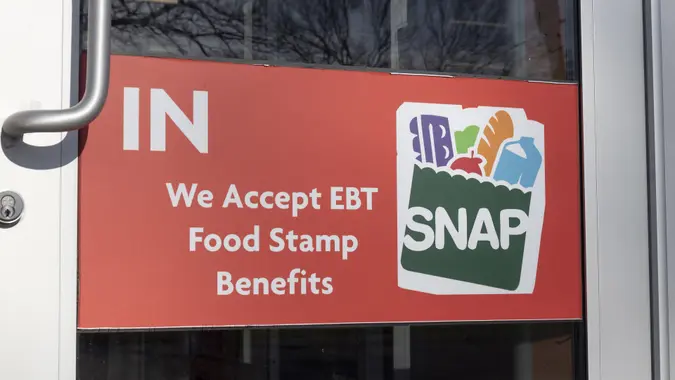I’m an Economist: How JD Vance Could Benefit Working Families Across the US

Commitment to Our Readers
GOBankingRates' editorial team is committed to bringing you unbiased reviews and information. We use data-driven methodologies to evaluate financial products and services - our reviews and ratings are not influenced by advertisers. You can read more about our editorial guidelines and our products and services review methodology.

20 Years
Helping You Live Richer

Reviewed
by Experts

Trusted by
Millions of Readers
Republican Vice-Presidential nominee JD Vance is ramping up his public appearances and sharing his position on key policies as the election approaches. One issue he’s been vocal about is increasing the Child Tax Credit, which is currently $2,000 per child for qualifying families.
“I’d love to see a child tax credit that’s $5,000 per child. But you, of course, have to work with Congress to see how possible and viable that is,” Vance said on “Face the Nation with Margaret Brennan.”
A higher tax credit would help working families. Case in point: In 2021, the American Rescue Plan Act temporarily boosted the Child Tax Credit from “$2,000 per child to $3,000 per child ($3,600 for a child under age 6)” to assist parents during the pandemic. The program helped reduce childhood poverty. However, according to experts GOBankingRates spoke with, a bigger tax credit could also come at a price that would strain the economy.
Financial Relief
While parenthood is filled with many joys, raising a child is a massive financial responsibility. According to Credit Karma, a child’s expenses average $16,227 and $18,262 a year, including housing, food, and childcare. To help offset financial pressures, the Child Tax Credit is a tool that helps parents.
“It puts downward pressure on child poverty rates, which, over time, leads to gains in human capital,” Peter C. Earle, Senior Economist, American Institute for Economic Research, said.
A tax credit increase to $5,000 could make a significant impact and benefit families in multiple ways.
“For a family with three children under age 17, this could mean $9,000 of additional dollars each year to make ends meet or take a special family vacation,” Davis McFarlane CFP®, CPA, Family Office Advisor with Greenleaf Trust, stated.
Boost Economic Growth
Another advantage of boosting the Child Tax Credit is more spending, which leads to economic growth.
“Increasing the child tax credit provides direct financial relief to families, which, by increasing discretionary income, may stimulate consumer spending,” Earle told GOBankingRates.
He added, “Since around 70% of the US GDP calculation involves consumption, the Child Tax Credit contributes directly to economic growth.”
Tax Policies Would Need to be Changed
In the “Face the Nation” interview, Vance proposed that the Child Tax Credit be extended to “all American families” and that he would like to see a “pro-family” program. The Republican vice president candidate stated he doesn’t want a “massive cut-off for lower-income families, which you have right now” and added, “You don’t want a different policy for higher-income families.”
Expanding the Child Tax Credit is a great campaign talking point, but complicated tax policies would need to be changed to balance the benefits for all families and avoid increasing debt.
“Since 1997, the CTC was designed and further modified to help low to middle-income families,” McFarlane said. “However, due to increased income phase-out thresholds (current phase-outs implemented as part of the 2017 TCJA) and limits on the refundable portion of the current CTC, it could be argued that middle-class and upper-middle-class taxpayers are receiving more benefit than lower-income taxpayers based on the CTC’s current design.”
McFarlane added, “Due to the current limits on the refundable portion of the CTC, many low-income taxpayers are already limited from receiving the full benefit of the current $2,000 per child.”
He pointed out, “Vance’s proposal to increase the CTC to $5,000 per child may not provide any additional benefit to those low-income taxpayers that are already limited by the refundable portion of the CTC, which is based on the taxpayer’s income. It is yet to be seen how Vance’s proposal would address the limits of the refundable portion of the CTC.”
Fiscal Challenges
A bigger tax credit would benefit families and has several advantages, but it would pose fiscal challenges.
“It may increase government spending and can exacerbate budget deficits if not offset by higher revenues in other areas,” Earle said.
Inflation is another concern experts have with increasing the Child Tax Credit.
Earlier this year, the Congressional Research Service summarized estimates by the Joint Committee on Taxation that the COVID expansion of the Child Tax Credit from $2,000 to $3,600 cost $105 billion annually. Burns noted that an even higher tax credit would come at a more significant price and with possible economic consequences.
“Generally, we would expect an increase in child tax credits to be stimulative and to increase debt and deficits absent any other changes,” Christopher D. Burns, CFA®, CPA, CFP® Vice President, Assistant Director of Research with Greenleaf Trust, explained.
“An expansion to $5,000 per child could cost in the neighborhood of $250 billion per year, depending on the ultimate design of the program,” Burns said. “The spending generated by those credits would likely be stimulative for growth and potentially for inflation.”
An Increased Child Tax Credit Could Discourage Some From Working
Additionally, there is concern about discouraging some from working if a higher tax credit is offered.
“The argument has also been made that such credits potentially create disincentives to work for some families, depending upon the way the credit is structured,” Earle said. “Like every other policy choice, modifications to the child tax credit comes with trade-offs.”
More Details Are Needed
Vance hasn’t provided a detailed plan for the increased Child Tax Credit policy, and he’s only spoken in generalities thus far. Burns said the following information is needed before determining the impact.
- At what income levels do the credits phase in and phase out?
- Are there any caps on the refundability of the credits?
- Will credits be adjusted for inflation in the future or not?
- Will monthly advance payments be a part of the proposal or not (as was the case during COVID)
- Whether the cost of the credits would be offset by an increase in tax revenue elsewhere in the budget or whether they would be fully deficit-financed.
Editor’s note on election coverage: GOBankingRates is nonpartisan and strives to cover all aspects of the economy objectively and present balanced reports on politically focused finance stories. You can find more coverage of this topic on GOBankingRates.com.
More From GOBankingRates
 Written by
Written by  Edited by
Edited by 

























